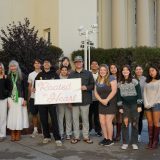Facing Fears as a Writer
October 8, 2018
By Sam Risak
Dual MA/MFA Student
 This fall, I moved from Florida and started the MFA in Creative Writing program at Chapman University. I’m starting to get settled here, but I’m not settling as a writer. In fact, it’s just the opposite.
This fall, I moved from Florida and started the MFA in Creative Writing program at Chapman University. I’m starting to get settled here, but I’m not settling as a writer. In fact, it’s just the opposite.
Only a few weeks into my first semester, and I’ve gained insight from writers who (unknowingly) articulated what had been a nebulous problem recurrent in my writing. At one of the Tabula Poetica readings this semester, visiting poet Sarah Ann Winn admitted she used to fear writing about sentimental topics (like her grandmother) because of the stigma of unoriginality surrounding sentimentality in literary writing. She worked past her hesitation, however, and reimagined potential clichés into the original forms readers find in her award-winning collection Alma Almanac.
After her reading, I thought back to several of my lackluster stories and realized I had muddled them to fit the expectations of my imagined readers. My interests in fiction cannot be contained to the strictly realistic world, and while speculative or magical-realist literary writers exist, academia often seems to pretend they don’t. Similar to Winn, I feared the bizarre would delegitimize my work. I found myself as someone with a Scooby-Doo-man-in-a-mask predictability, my character’s mental distress rationalizing every fantastic scenario I wrote. Fortunately, Chapman’s MFA—unlike many in the country—talks about speculative fiction and magical realism as valid options for students. That assurance has allowed me to start experimenting and pushing further as a writer.
In Aspects of a Writer, a class incoming MFA students take together, we’re reading Creative Quest, a book that discusses breaking creative comfort zones. Musician-turned-author Questlove refers to the music video “Stan” by Eminem, admiring how it takes a private fear—that of an obsessive fan—and follows it to the worst possible end. The video isn’t something you’d want to bring up in everyday conversation, which is why it succeeds; it disturbs us from the root.
I’m not suggesting that every piece of writing needs to be transformed into horrific nightmare. In fact, Winn’s transformative use of forms (like how-to lists and image captions) allows her to embrace the sentimental. I’m suggesting that the most honest and interesting pieces are often made when the creator follows an idea to the furthest possible conclusion. For me, this means that whatever weird images I write into my stories need to be actualized, not dismissed as manifestations of the mind. For another story, poem, or essay (or really, any form of art), it might be an image or memory that the piece has been tiptoeing around. It’s easy for writers to shape their writing based on how they want to be perceived by other writers, but, at the end of the day, if we are left unsatisfied, our readers will likely be as well.
When we control much of what we present to the world, reading what others aren’t comfortable showing can help alleviate alienation against the strangeness we perceive in ourselves. In first drafts, my fear to step outside the confines of realistic fiction shows, my characters too grounded in the real world, their experiences all plausibly justifiable. Only afterward, in revision, can I see my logic as a way of ensuring distance between myself and the reader. In the MFA program, I have discovered an insecurity I was not previously aware I had. Now that I can see it, I can overcome it and produce something I—and, I hope, others— will want to read.

